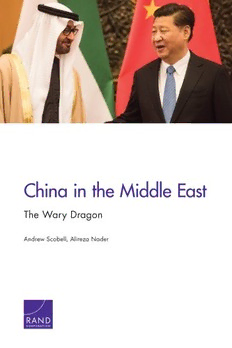
China in the Middle East: the Wary Dragon PDF
Preview China in the Middle East: the Wary Dragon
ARROYO CENTER China in the Middle East The Wary Dragon Andrew Scobell, Alireza Nader Prepared for the United States Army Approved for public release; distribution unlimited For more information on this publication, visit www.rand.org/t/RR1229 Library of Congress Cataloging-in-Publication Data is available for this publication. eISBN: 978-0-8330-9272-4 Published by the RAND Corporation, Santa Monica, Calif. © Copyright 2016 RAND Corporation R® is a registered trademark. Cover: Photo by Fred Dufour/Associated Press. Limited Print and Electronic Distribution Rights This document and trademark(s) contained herein are protected by law. This representation of RAND intellectual property is provided for noncommercial use only. Unauthorized posting of this publication online is prohibited. Permission is given to duplicate this document for personal use only, as long as it is unaltered and complete. Permission is required from RAND to reproduce, or reuse in another form, any of its research documents for commercial use. For information on reprint and linking permissions, please visit www.rand.org/pubs/permissions. The RAND Corporation is a research organization that develops solutions to public policy challenges to help make communities throughout the world safer and more secure, healthier and more prosperous. RAND is nonprofit, nonpartisan, and committed to the public interest. RAND’s publications do not necessarily reflect the opinions of its research clients and sponsors. Support RAND Make a tax-deductible charitable contribution at www.rand.org/giving/contribute www.rand.org Preface This research is part of the fiscal year 2014 project “China Pivots to the Middle East.” The project examined China’s economic, political, and military roles in the Middle East and provided insights to help inform U.S. Army decisions regarding presence and force posture in the region. This report examines China’s interests in and strategy toward the Middle East. Specifically, the report explores China’s economic, politi- cal, and security role in the region, with particular attention to China’s relations with Saudi Arabia and Iran. Finally, the report contemplates the consequences of the Chinese strategy toward the Middle East for the United States and, more specifically, the U.S. Army. The research and writing of the report were completed in October 2014(cid:15) This research was sponsored by Deputy Chief of Staff, G-8, U.S. Army, and conducted within the RAND Arroyo Center’s Strategy, Doctrine, and Resources Program. RAND Arroyo Center, part of the RAND Corporation, is a federally funded research and development center sponsored by the United States Army. The Project Unique Identification Code (PUIC) for the project that produced this document is HQD136620. iii Contents Preface ............................................................................. iii Figures .............................................................................vii Summary ......................................................................... ix Acknowledgments ............................................................... xi CHAPTER ONE Introduction ...................................................................... 1 CHAPTER TWO How Important to China Is the Middle East? ............................... 3 History .............................................................................. 3 Does China Have a Middle East Strategy?...................................... 5 China’s Interests and Objectives in the Middle East ........................... 7 Conclusion ........................................................................ 20 CHAPTER THREE China Engages Saudi Arabia ................................................. 23 Chinese Instruments and Mechanisms ........................................ 24 Conclusion .........................................................................45 CHAPTER FOUR China and Iran—Close but Complicated ...................................49 The Growth of Ties in the Wake of Iran’s Revolution ........................53 Military and Nuclear Cooperation ..............................................55 Economic and Energy Cooperation ............................................59 China and Sanctions ..............................................................61 v vi China in the Middle East: The Wary Dragon Relations Under Rouhani ....................................................... 64 Conclusion .........................................................................71 CHAPTER FIVE Whither the Wary Dragon? Implications for the United States ........73 Mismatch in the Middle East....................................................74 The Elephant in the Room ...................................................... 77 Recommendations ................................................................79 Abbreviations .....................................................................85 References ....................................................................... 87 Figures 2.1. Top Exporters of Petroleum to China, by Value .................. 8 3.1. High-Level Chinese and U.S. Visits to Saudi Arabia ........... 28 3.2. Saudi Petroleum Exports to the United States and China ..... 36 3.3. SIPRI TIVs of Official Arms Exports to Saudi Arabia ......... 42 vii Summary This study examines China’s economic, political, and security roles in the Middle East, focusing on China’s relations with Saudi Arabia and Iran. The study explores what China is doing in the Middle East and why. Once considered by Beijing as a peripheral and relatively insig- nificant region of the world, the Middle East now looms much larger in China’s national security calculus than ever before. Beijing’s unprec- edented interest and involvement in the Middle East raises the question of what is driving this activism. What explains China’s increased atten- tion to the Middle East, and what are the implications of this develop- ment for the United States? The findings of this study suggest that Beijing is driven primarily by economic interests, as well as an attempt to “rebalance” its domes- tic, foreign, and security policies so that these are less skewed in favor of eastern China and East Asia. Greater interest and involvement in the Middle East are manifestations of growing dependence on energy resources from the region and Chinese efforts to “march west” into Central Asia and beyond. With the launch of the New Silk Road initia- tive, officially announced by President Xi Jinping in September 2013, Beijing’s Middle East strategy was subsumed under a grand and highly ambitious effort to build the overland Silk Road Belt and the Maritime Silk Road linking China to the Middle East and beyond. While coun- tering the United States is a factor, it is not the central driver of China’s Middle East strategy. This report recommends that the United States welcome some expanded Chinese security engagement in the Middle East. Indeed, given the region’s vital importance to China’s economy and China’s ix
